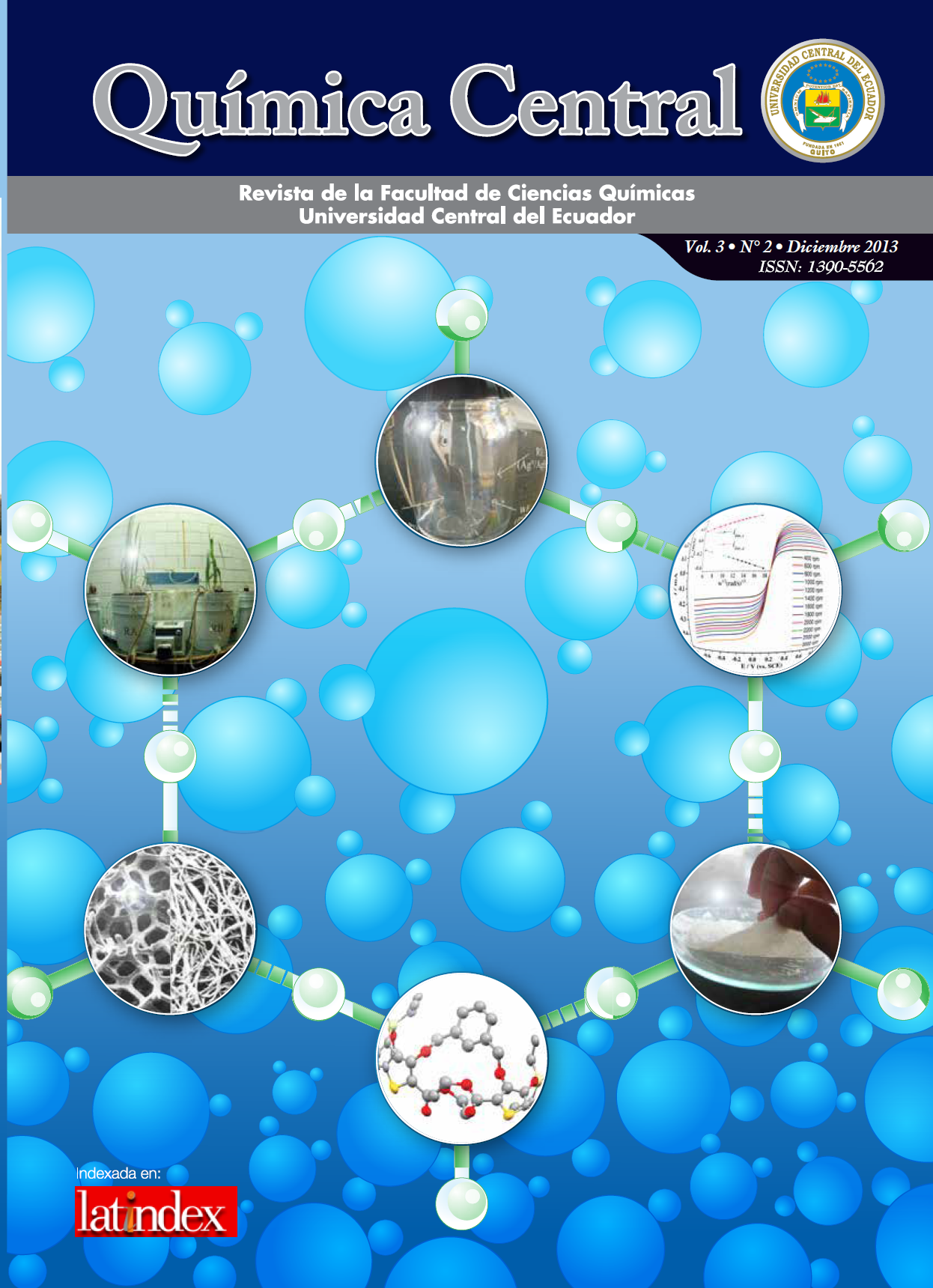Síntesis de Sistemas bis-tiofénicos con puente α,α’-dioxi-m-xileno
DOI:
https://doi.org/10.29166/quimica.v3i2.1208Palabras clave:
Puente α,α’-dioxi-m-xileno, Williamson, Mitsunobu, 3,4-dialcoxitiofenoResumen
Las reacciones de formación de aril-alquil éteres mediante las reacciones de Mitsunobu y de Williamson fueron evaluadas en la síntesis de sistemas bis-tiofénicos con puente α,α’-dioxi-m-xileno. Se obtuvieron rendimientos más altos y una purificación más fácil al utilizar la metodología de Mitsunobu en baño sónico.
Descargas
Citas
Mishra, A.; Ma, C.Q.; Bäuerle, P. (2009). Functional Oligothiophenes: Molecular Design for Multidimensional Nanoarchitectures and Their Applications. Chemical Reviews, 109, 1141–1276.
(a) Panchamukhi, S. I.; Belavagi, N.; Rabinal, M. H.; Khazi, I. A. (2011). Synthesis and Optoelectronic Properties of Symmetrical Thiophene Based 2,5-disubstituied 1,3,4-oxadiazoles: Highly Fluorescent Materials for OLED Applications. Journal of Fluorescence, 21, 1515-1519. (b) Durban, M. M.; Kazarinoff, P. D.; Luscombe, C. K. (2010). Synthesis and Characterization of Thiophene-Containing Naphthalene Diimide n-Type Copolymers for OFET Applications. Macromolecules, 43, 6348–6352. (c) Terzi, F.; Zanfrognini, B.; Zanardi, C.; Pigani, L.; Seeber, R. (2011). Poly(3,4-ethylenedioxythiophene)/ Au-nanoparticles composite as electrode coating suitable for electrocatalytic oxidation. Electrochimica Acta, 56,3575–3579. (d) Sahina, O.; Oskena, I.; Ozturka, T. (2011). Investigation of electrochromic properties of poly(3,5-bis(4-methoxyphenyl)dithieno[3,2-b;2′,3′-d]thiophene). Synthetic Metals, 161, 183–187. (e)Rozlosnik, N. (2009) New directions in medical biosensors employing poly(3,4-ethylenedioxy thiophene) derivative-based electrodes Analytical and Bioanalytical Chemistry, 395, 637–645. (f) Batista, R. M. F.; Oliveira, E.; Nuñez, C; Costa, S. P. G.; Lodeiro, C.; Raposo, M. M. M. (2009). Synthesis and evaluation of new thienyl and bithienyl-bis-indolylmethanes as colorimetric sensors for anions. Journal of Physical Organic Chemistry, 22, 362–366. (g) Qi, Z.J.; Wei, B.; Sun, Y.M.; Wang, X.M.; Kang, F.; Hong M.X.; Tang, L. L.(2011). Comparative study of photoelectric properties of regiosymmetrical poly(3,4-dialkoxythiophene)s. Polymer Bulletin, 66, 905–915.
(a) Heywang, G.; Jonas; F.(1992) Poly(alkylenedioxythiophene)s—new, very stable conducting polymers. Advanced Materials, 4, 116-118. (b) Dietrich, M.; Heinze, J.; Heywang, G.; Jonas, F. (1994) Electrochemical and spectroscopic characterization of polyalkylenedioxythiophenes. Journal of Electroanalytical Chemistry, 369, 87-92. (c) Groenendaal, L.,B.; Jonas, F.; Freitag, D.; Pielartzik, H.; Reynolds, J.R. (2000). Poly(3,4-ethylenedioxythiophene) and Its Derivatives: Past, Present, and Future. Advanced Materials, 12, 481-494.
J. Roncali. (1997). Synthetic Principles for Bandgap Control in Linear π-Conjugated Systems Chemical Reviews, 97, 173-205.
ten Hoeve, W.; Wynberg, H.; Havinga, E. E.; Meijer, E. W. (1991). Substituted 2,2’:5’, 2’’:5’’, 2’’’:5’’’, 2’’’’:5’’’’, 2’’’’’:5’’’’’, 2’’’’’’:5’’’’’’,2’’’’’’’:5’’’’’’’, 2’’’’’’’’:5’’’’’’’’, 2’’’’’’’’’:5’’’’’’’’’, 2’’’’’’’’’’ -undecithiophenes, the longest characterized oligothiophenes. Journal of the American Chemical Society, 113, 5887-5889.
Miller, L.L.; Mann., K.R. (1996). π-Dimers and π-Stacks in Solution and in Conducting Polymers. Accounts Chemicals Research, 26, 417-423.
(a) Rajakumar, P.; Dhanasekaran, M.; Selvanayagam, S.; Rajakannan, V.; Velmuruganb, D.; Ravikumarc, K. (2005). Synthesis and structural analysis of isomeric pyridinophanes and thiacyclophanes. Tetrahedron Letters, 46, 995–999. (b) Elmer, S. L.; Zimmerman, S. C. (2004). Cross-Linking Dendrimers with Allyl Ether End-Groups Using the Ring-Closing Metathesis Reaction. Journal of Organic Chemistry, 69,7363-7366.
Gogte, V.N. ; Shah, L.G. ; Tilak, B.D. ; Gadekar, K.N.; Sahasrabudhe, M.B. (1967) Synthesis of potential anticancer agents-I. Synthesis of substituted thiophenes. Tetrahedron, 23, 2437-2441.
Aldrich-Sigma. Beil. 6,914. Aldrich MSDS 1, 153:A / Corp MSDS 1 (1), 350:B / FT-IR 2 (2), 1930:B / FT-IR 1 (1), 1132:A / IR-Spectra (3), 680:B / NMR-Reference 2 (1), 935:D / RegBook 1 (1), 1323:L / Structure Index 1, 203:C:2 / Vapor Phase 3, 1056:B.
Cisneros-Pérez, P.A. 2010. Contribución a la síntesis de Sistemas bis-tiofénicos con puente α,α’-dioxi-m-xileno como unidad central. Tesis de Maestría en Ciencias. Programa de Maestría y Doctorado en Ciencias Químicas. UNAM. México, D.F. México.
Kocienski, P. (1994), Protecting groups, Thieme, Stuttgart.
Borah, R.; Deka, N.; Sarma, J.C. (1997). Iodine as an Acetyl Transfer Catalyst. Journal of Chemical Research (S), 110–111.
Caras-Quintero, D; Bäuerle, P. (2002). Efficient synthesis of 3,4-ethylenedioxythiophenes (EDOT) by Mitsunobu reaction. Chemical Communications, 2690-2691.
Picraux, L. B.; Smeigh, A. L.; Guo, D.; McCusker, J. K. (2005). Intramolecular Energy Transfer Involving Heisenberg Spin-CoupledDinuclear Iron-Oxo Complexes. Inorganic Chemistry, 44, 7846-7859.
Smith M.B. (2002). Organic Synthesis 2nd ed. New York, McGraw-Hill.
Lepore, S. D.; He, Y. (2003). Use of Sonication for the Coupling of Sterically Hindered Substrates in the Phenolic Mitsunobu Reaction. Journal of Organic Chemistry, 68, 8261-8263.
Descargas
Publicado
Cómo citar
Número
Sección
Licencia
Los originales publicados en las ediciones impresa y electrónica de esta revista QUÍMICA CENTRAL son propiedad de la Universidad Central del Ecuador, siendo necesario citar la procedencia en cualquier reproducción parcial o total.
La propiedad intelectual de los artículos publicados en revista QUÍMICA CENTRAL pertenece al/la/los/las autor/a/es/as, y los derechos de explotación y difusión científica están direccionados para la revista QUÍMICA CENTRAL mediante CARTA DE AUTORIZACIÓN DE PUBLICACIÓN publicada en esta plataforma.


